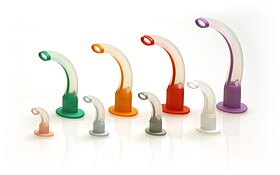GLUDEAL AIRWAY ( oropharyngeal airway )
GLUDEAL AIRWAY ( oropharyngeal airway )
An oropharyngeal airway (also known as an oral airway, OPA or Guedel pattern airway) is a medical device called an airway adjunct used in airway management to maintain or open a patient's airway. It does this by preventing the tongue from covering the epiglottis, which could prevent the person from breathing. When a person becomes unconscious, the muscles in their jaw relax and allow the tongue to obstruct the airway.
Insertion
The correct size OPA is chosen by measuring from the first incisors to the angle of the jaw. The airway is then inserted into the person's mouth upside down. Once contact is made with the back of the throat, the airway is rotated 180 degrees, allowing for easy insertion, and assuring that the tongue is secured. An alternative method for insertion, the method that is recommended for OPA use in children and infants, involves holding the tongue forward with a tongue depressor and inserting the airway right side up.
The device is removed when the person regains swallow reflex and can protect their own airway, or it is substituted for an advanced airway. It is removed simply by pulling on it without rotation.
Usage
Use of an OPA does not remove the need for the recovery position and ongoing assessment of the airway and it does not prevent obstruction by liquids (blood, saliva, food, cerebrospinal fluid) or the closing of the glottis. It can, however, facilitate ventilation during CPR (cardiopulmonary resuscitation) and for persons with a large tongue






Comments
Post a Comment